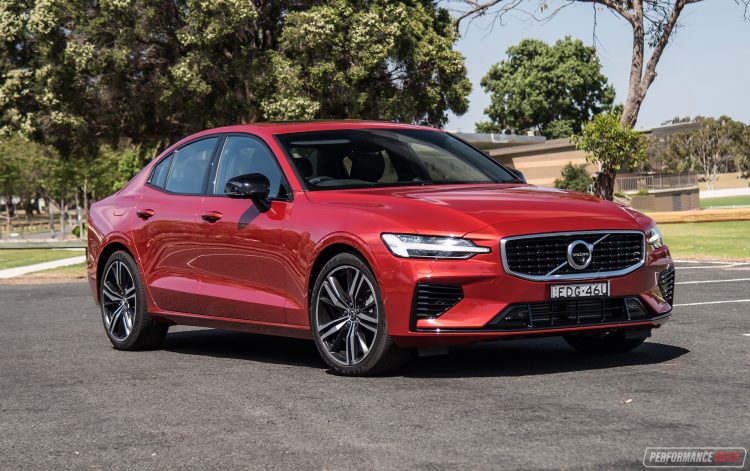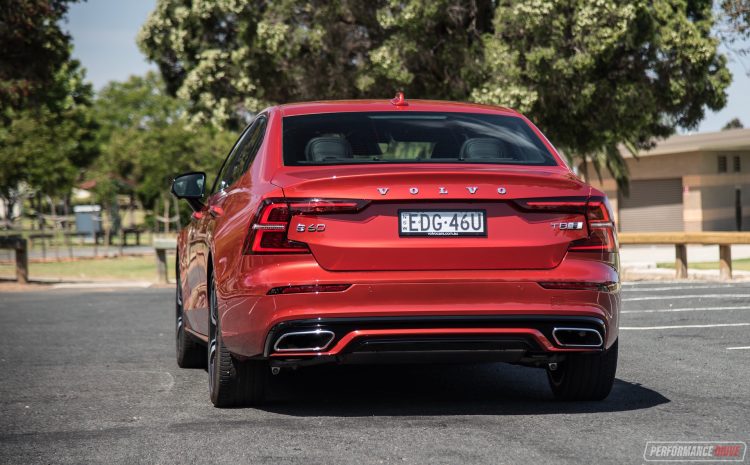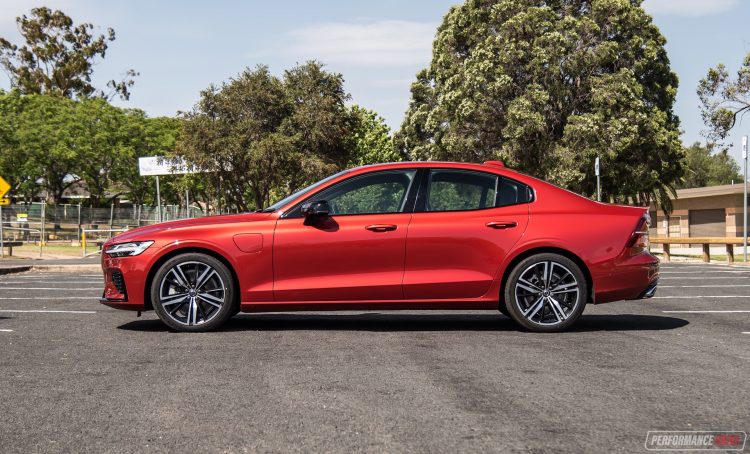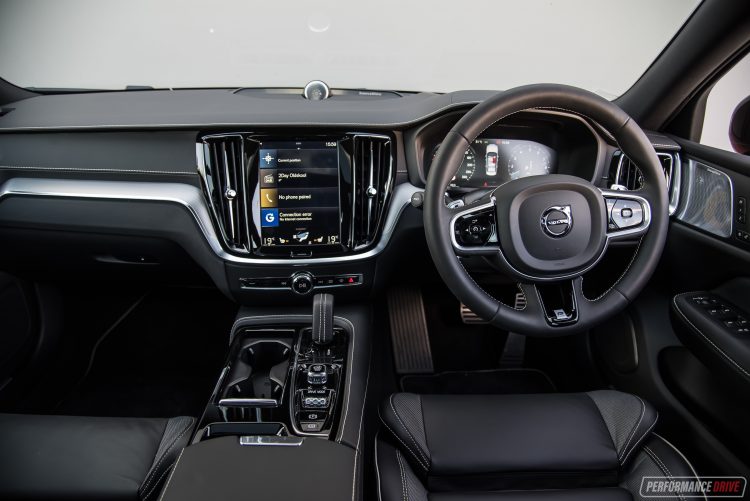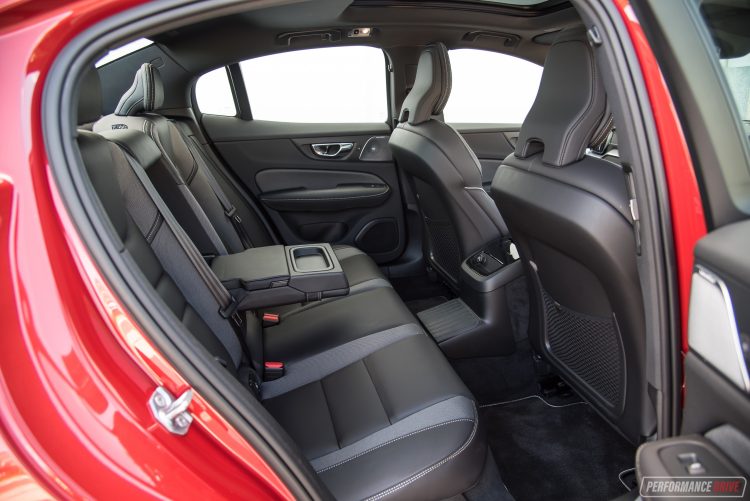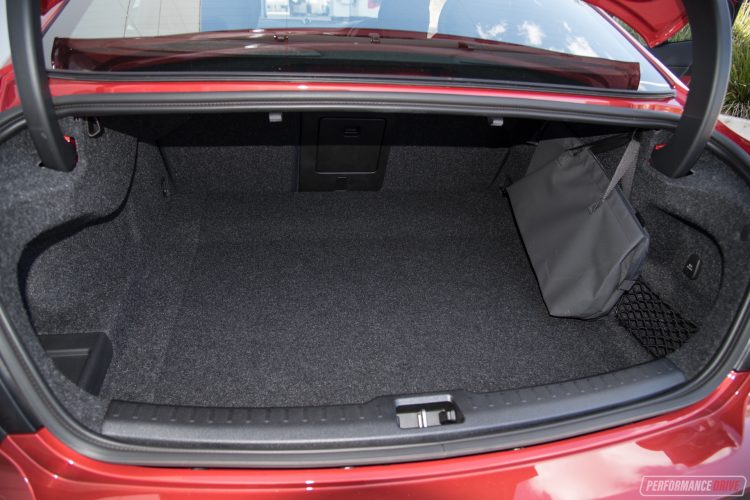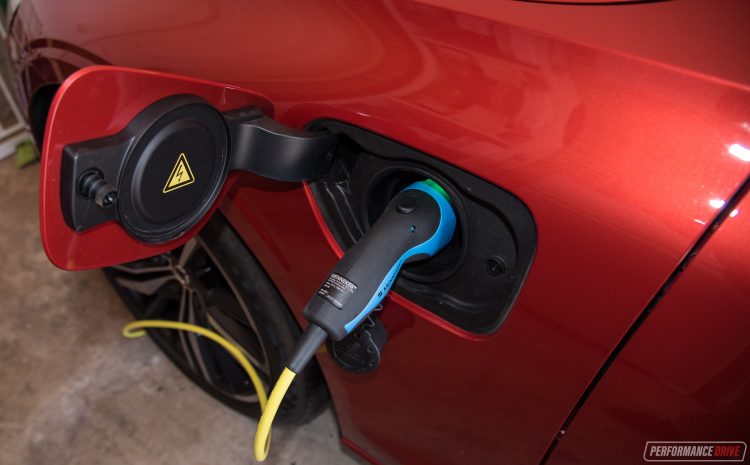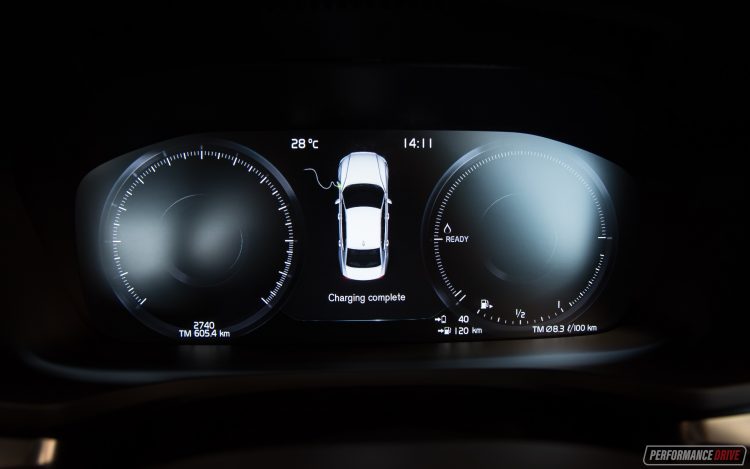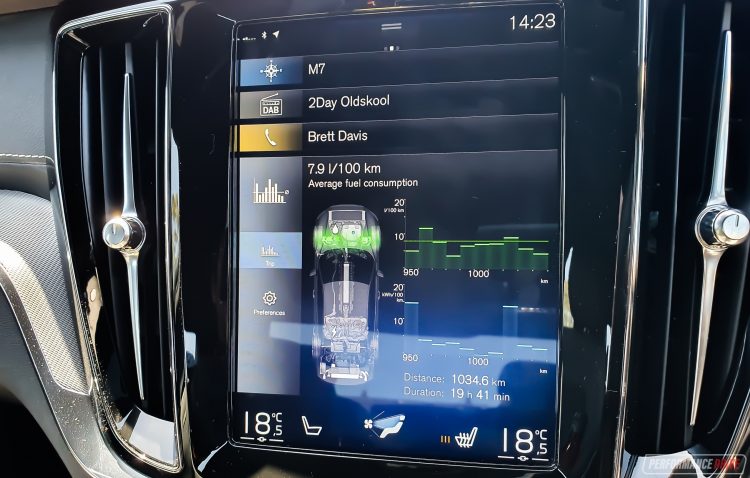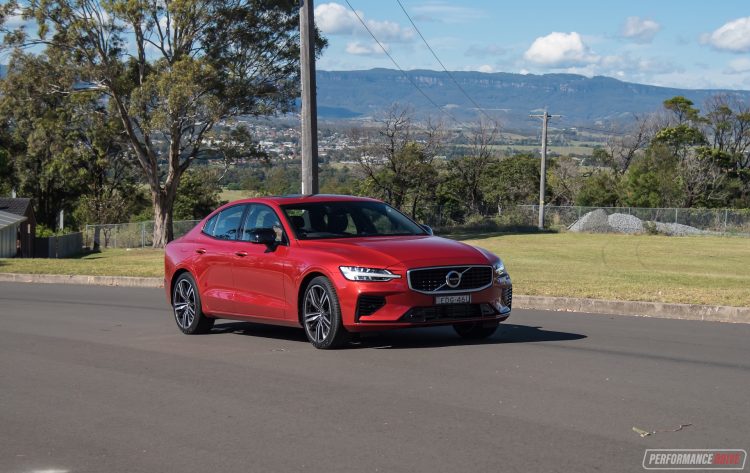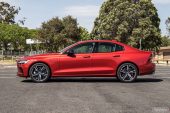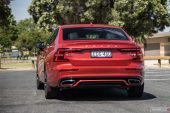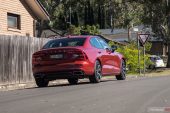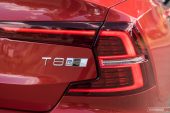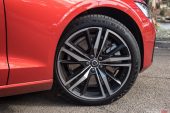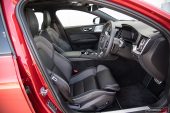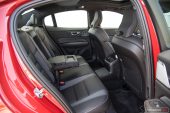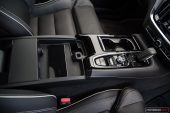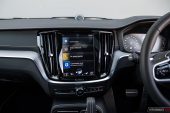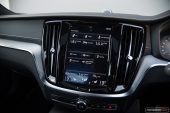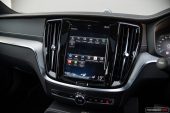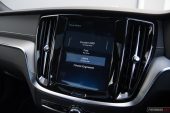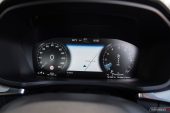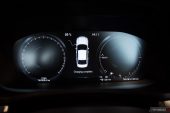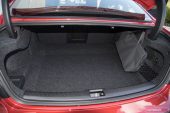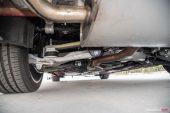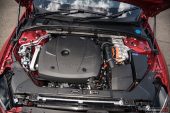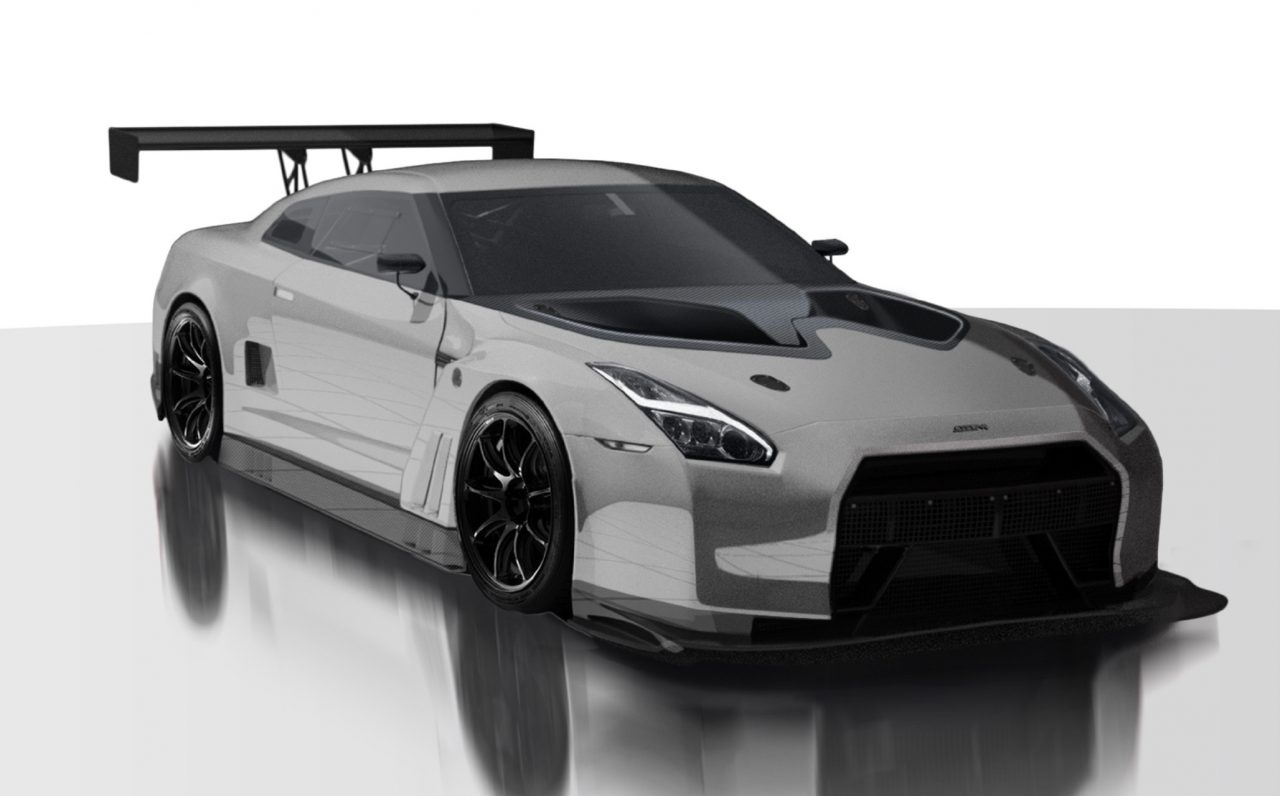Let’s not waste any time here, this is a really lovely car. So graceful. Majestic, even. And in that respect, very refreshing for the often overly-sporty mid-size premium sedan market.
The 2020 Volvo S60 brings a distinctively suave and Swedish cocktail to the executive party, targeting those who enjoy a finer class of driving against all of the athletic-focused rivals. That’s not to say it’s as lazy and lethargic as watching fishing in TV. This T8 variant might be a plug-in hybrid but it’s also the most powerful vehicle in its class, producing 311kW and 670Nm.
We say ‘class-leading’ because there are no other vehicles in this segment that produce more power and torque. Sure, there are hardcore rivals, such as the BMW M3 (331kW) and the Alfa Romeo Giulia QV (375kW), but the S60 T8 is hardly a contender for those and it’s not intending to be. Instead, it takes on the likes of the Audi S4 (260kW), BMW M340i (275kW), Infiniti Q50 Red Sport (298kW), and the Mercedes-AMG C 43 (287kW).
The T8 comes in R-Design form only in Australia, which means it does feature some sporty-inspired enhancements, such as a discreet aero kit for the body, bespoke 19-inch alloy wheels, and some snug bucket seats inside. Prices for the T8 start from $85,990 (excluding on-roads), which is at the lower end of this specific market.
2020 Volvo S60 T8 R-Design – THE SPECS
[column width=”47%” padding=”6%”]Engine: 2.0-litre turbo and supercharged four-cylinder hybrid
Output (combined): 311kW / 670Nm
Transmission: Eight-speed auto
Drive type: All-wheel drive (electric rear axle)
Wheels: F & R: 19×8.0, 235/40
ANCAP: Five stars
Tare weight: 2006kg
Power-to-weight: 6.45:1 (kg:kW)
Official fuel economy: 2.0L/100km
Economy during test: 7.9L/100km
Fuel capacity/Type: 60L/95 RON[/column] [column width=”47%” padding=”0″]Power efficiency: 155.5kW:L/100km
0-60km/h: 2.61 seconds*
0-100km/h: 5.12 seconds*
60-110km/h: 3.28 seconds*
1/8 mile: 8.84 seconds at 138.9km/h*
1/4 mile: 13.52 seconds at 168.6km/h*
Max acceleration: 0.846g
100-0km/h braking: 2.84 seconds at 36.70 metres*
Max deceleration: -1.217g
Decibel at idle: 46*
Peak decibel at 60-100km/h: 80*
Priced from: $85,990[/column][end_columns]
* Figures as tested by PerformanceDrive on the day. Factory claims may be different
2020 Volvo S60 T8 R-Design – THE PACKAGE
Now in its third generation, launching in Australia in May this year, the 2020 S60 jumps from the old Ford-based P3/EUCD platform to Volvo’s latest Scalable Product Architecture (SPA). The SPA layout is used for all of Volvo’s latest mid-to-large models, including the XC60, XC90, and S90/V90. Volvo says the new platform has helped bring significant improvements in collision protection and safety. It also provides a transverse/FWD engine layout and supports all-wheel drive. More on the tech stuff later.
The new platform sees increases not just the external dimensions over the predecessor, but also helps create a more spacious and clutter-free cabin for all passengers. According to the specs, the new S60 is 126mm longer, but 15mm narrower and 47mm lower than the old model. However, the wheelbase, which is the important bit in the middle, is 96mm longer. In the metal it does look much bigger than the previous model, and seems almost too large to compete with the aforementioned rivals. We think a lot of this perception has to do with the firm, slab-like proportions within the design.
There is a huge amount of room and sense of spaciousness inside, especially compared with the rivals. The front of the cabin is calm and soothing with its soft Scandinavian tones and minimalist layout for the buttons and controls. In fact, almost all controls are packed into a slick 9.0-inch vertical-oriented touch-screen system. It’s pretty easy to navigate through the screen, once you become familiar with the left-right main menu screens. There’s also a settings menu which is somewhat hidden, dropping down from the top-centre.
Volvo has gone for a mostly black theme for the graphics, with only some plashes of colour from the in-built apps. All other digital ‘buttons’ are white. In that sense it does go with the same philosophy that’s applied to the rest of the car, in that it’s relaxing, fuss-free and a little bit inconspicuous. Included apps keep you entertained and up to date, such as digital radio by TuneIn, Google Search, WikiLocation, Spotify, Yelp, and weather. This test car showcases the superb 15-speaker Bowers & Wilkins sound system, too. It produces incredible clarity and bass, with exquisite speaker grilles, however, it does set you back $3462. Or, as featured here, it can be packaged together by optioning for the Premium pack for $5000 (includes panoramic sunroof and rear sun blind).
The attention to detail with most of the fixtures is rather nice, with brushed and knurled metal-style switchgear for the climate vents and twist-knob start button, and for the unique roller drive mode selector. We like that most areas are featured in premium and quality trimming, including the B-pillar, which is covered in proper fabric trim unlike the common black plastic used on other premium vehicles. There’s also ample storage around the console, twin cup holders, and a dedicated pocket for your phone with charging ports under the centre arm rest.
Passenger space and comfort is easily right up there at the benchmark of the class in our opinion. Headroom and legroom in the front is impressive for a mid-sizer, but it’s the sense of space that tends to make it really easy to get comfortable. We find the driving position to be spot-on as well, with a highly adjustable steering column (tilt and reach) and power front seats. These R-Design seats in the front are also some of the best you’ll find in this class. You can even adjust the front-most under-thigh section, and close in or release the end tabs. There’s also optional massage functions available ($769). With a relatively high centre console and flat and high dash, you do get that hunkered-down stance that this class is known for, but if you prefer you can raise the seat right up high for a perched view.
In the back the outer passengers enjoy loads of legroom, with big and wide footwells helping to perpetuate that sense of freedom and relaxation. Oddly, there are no cup holders in the back despite there being a sizeable flip-down arm rest with plenty of space for cup holders. There are bottle holders in the doors though, and the arm rest does offer a flip-up storage case. Climate vents are cleverly positioned in the B-pillars, but that means the middle passenger only gets air from the front. We can’t seem to find any option for rear climate control either to adjust the temp in the back. We guess if rear seat accommodation is really important to you, you’ll want to step up to the S90 anyway, which does offer such facilities.
Right at the back the boot opens up to 390 litres of cargo capacity. It’s not the largest boot in the class. Actually, it’s one of the smallest, but that’s mainly due to the electric systems for this T8 hybrid variant. Non-hybrid S60 models offer a more competitive 442L. You might notice an unusual handbag-looking pouch hanging from the boot hinge. This houses the charge cord and can be tethered up so it doesn’t fling about.
2020 Volvo S60 T8 R-Design – THE DRIVE
Going for the T8 model gets you the “twin engine”, as Volvo calls it, plug-in hybrid powertrain. It’s all-wheel drive, with the rear axle powered by a 65kW/240Nm electric motor. Under the bonnet is a 2.0-litre turbo and supercharged petrol four-cylinder engine that develops 246kW at 6000rpm, and 430Nm between 2200-4500rpm. Paired together they produce an impressive 311kW and 670Nm. As mentioned at the start, the outputs place it at the top of the sub-performance class.
In regular driving scenarios the powertrain is really, really smooth and peaceful. More so than any other car in this class, except perhaps the Lexus ES 300h hybrid which is also very pleasant. A lot of this is thanks to the T8’s ability to drive from the electric motor alone. The range is about 40km, however, as you only have 65kW at your disposal, faster-tempo driving will soon see that range drop quite rapidly. The S60 T8 is also a hefty machine, weighing in at 2006kg (tare). That’s very heavy for this class. So, as you can imagine, 65kW doesn’t really suffice for anything but cruising. Trundling around the city, sure. It is adequate, which means you could get around without using any petrol. There is a seperate petrol gauge and battery level gauge within the instrument cluster so you can keep an eye on it.
There are a number of driving modes to select from, including Constant (AWD with both petrol and electric constantly working), Pure (electric only), Hybrid (a combination of petrol and electric, automatically turning off petrol when available), and then Polestar (for sheer performance). Out of all of these modes there doesn’t seem to be any charge modes. For example, we know some electric-hybrids out there, like the Mitsubishi Outlander PHEV, can run the petrol motor to charge the battery. We tried fiddling in the menus here but we couldn’t find a setting that could recharge the battery. In Constant mode you will notice the battery level increase during steady cruising, but it won’t charge beyond around 15 per cent. Well, it didn’t for us anyway.
In our opinion the best mode and the most suitable for the S60’s character is simply the default Hybrid mode. The engine seamlessly switches on when needed but you get very smooth and silent electric driving under light loads and when cruising. The official fuel consumption is rated at just 2.0L/100km, and that includes mixed conditions, such as stop-start traffic and highway driving. In the real world though, this test car didn’t produce anywhere near that. Over a week of testing (1034km), with lots of highway driving during the daily commute and some performance testing, the trip computer reported 7.9L/100km for us.
That’s not the most attractive fuel consumption figure for the class, especially for a vehicle that’s promoting itself as an eco-friendly hybrid. However, you soon remember this machine offers 311kW and an official 0-100km/h time of 4.3 seconds. And the fact that you can plug it in and charge it up is a bonus. For example, if you live around 20km from work, you could technically drive this every day without using any fuel at all. So the potential is definitely there to reduce that consumption given the right circumstances.
As for the performance side of things, Volvo’s 0-100km/h claim is very optimistic. Using our Vbox Sport (a very accurate GPS-based timer from an industry-renowned manufacturer), the best we could produce was 5.12 seconds (at around 18 degrees Celsius). We ensured the battery was as close to fully charged as possible, and as usual, we ran the car in all driving modes and applied different take-off methods (brake loading, for example) to give it the best opportunity to reveal its full potential. While 4.3 seconds would be hugely impressive for this class, 5.12 seconds is still a properly quick time for a luxury sedan. We simply think Volvo is being unrealistic by claiming 4.3.
Along a spirited road the new platform shuffles and hustles through and between bends with great confidence and decent engagement. It is a heavy vehicle, as mentioned, so it’s not as pin-sharp as some competitors. But then again, it is not intending to be and the only sacrifice is a soothing character at the other end of the driving spectrum. The steering feel is light and responsive enough to support sporty driving, but the connected components, such as the suspension and tyres, limit the outright potential the more vigorous you get. Stability and composure is great right up to near the limit, but again, the suspension isn’t as tied-down as some rivals so it will eventually nudge the bump-stops. On smooth surfaces it obviously nails it with more precision, although understeer is the first link to weaken, as expected for an AWD.
Lastly, we can’t talk about a Volvo without mentioning the S word. Safety is paramount with the latest S60. And the T8 comes with everything that Volvo has to offer for this class. Standouts such as Pilot Assist cruise control with automatic steering (for a limited period), crisp parking cameras with manually selectable view points, and run-off road protection all put rivals to shame. In particular, the cruise control shows huge awareness for its surroundings, monitoring the traffic and anticipating when to and not to brake better than any competitor that we’ve driven. It’s also great that you can toggle the auto steering on and off, for those who prefer traditional cruise control. For further peace of mind, ANCAP has of course awarded its full five star safety rating.
2020 Volvo S60 T8 R-Design – THE VIDEO
2020 Volvo S60 T8 R-Design – THE VERDICT
The S60 T8 is a pleasure to drive. It’s not as outright sporty as many rivals, but instead it offers a very relaxing and noticeably more comfortable character which will appeal to many buyers. The technology is also very impressive, particularly the touch-screen and advanced safety systems. We also like the polished and perfected cabin materials, the cool Swedish design, and the fact that it is something a bit different to the usual suspects in this class – all of which seem to strive for outright taut and toned athleticism, for some reason. Despite not being as economical or as quick as the official figures suggest, the numbers are still highly commendable.
[column width=”47%” padding=”6%”]PROS:
– Very smooth and relaxing drive
– Good performance from T8
– Suave interior with high-quality materials throughout
– Slick touch-screen
– 40km of electric range and can be recharged via normal socket
[/column] [column width=”47%” padding=”0″]CONS:
– Real-world fuel economy is way higher than official average of 2.0L/100km
– Not as quick as Volvo’s 4.3-second 0-100km/h claim
– Heavy for the class (2006kg)[/column][end_columns]
As always, if you’re thinking about buying a new car don’t forget to click here to speak with our car buying specialists.
